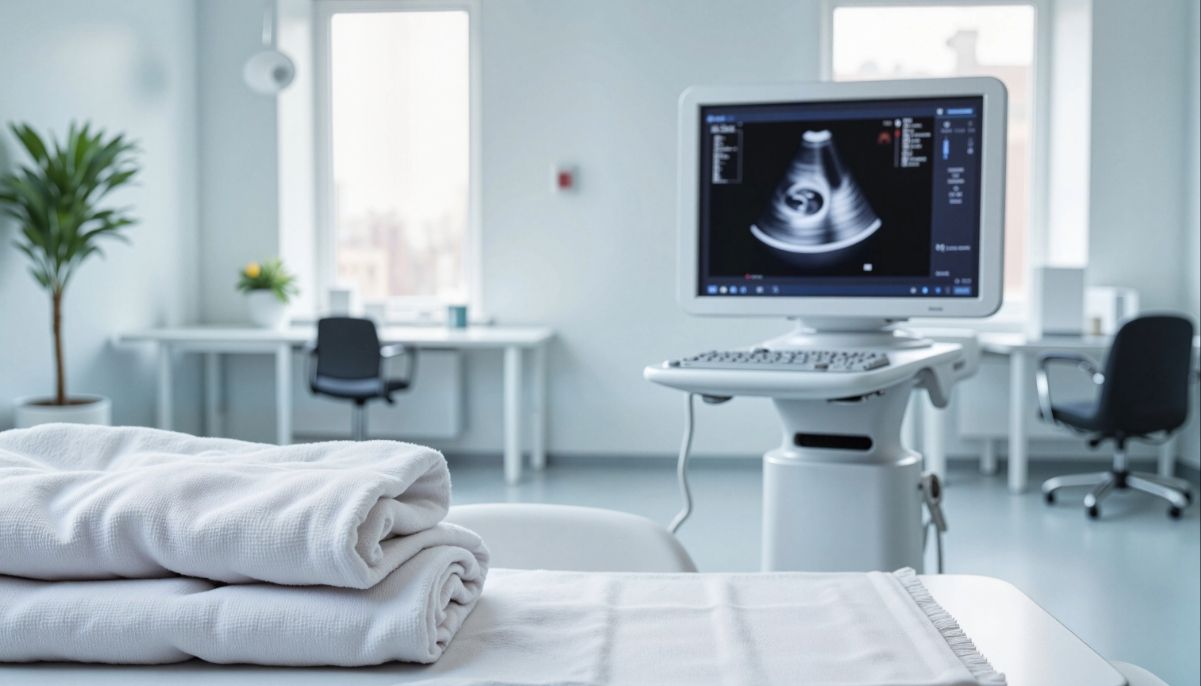The Impact of AI on the Women’s Health Ultrasound Ecosystem
Introduction
Artificial intelligence is reshaping women’s health ultrasound—transforming it from a purely operator-dependent art into a faster, more consistent, and more precise science. In obstetric, gynecologic, and breast imaging, AI-powered tools now automate complex measurements, highlight subtle anomalies, and optimize image quality in real time. The result is shorter exam times, more reproducible results, and earlier detection of critical conditions—benefiting clinicians, patients, and healthcare systems alike. Leading manufacturers such as Philips, Samsung, GE, and Mindray are embedding advanced AI capabilities directly into their flagship systems, redefining what’s possible in women’s health imaging.
AI Applications in Women’s Health Ultrasound
1. Obstetric Imaging
AI algorithms now perform automated fetal head circumference, abdominal circumference, and femur length measurements with accuracy comparable to experienced sonographers. This shortens exam times and ensures consistency in prenatal monitoring.
Example: Philips’ AI-driven obstetric workflow can generate multiple biometry measurements from a single sweep, dramatically reducing keystrokes and scan duration.
2. Gynecologic Ultrasound
In gynecology, AI assists in detecting and characterizing lesions, mapping fibroids, and assessing ovarian structures, improving the speed of diagnosis and aiding surgical planning.
3. Breast Imaging
AI improves lesion detection in dense breast tissue and helps categorize findings using standardized BI-RADS® descriptors. Automated whole-breast scanning systems can cover large volumes quickly while AI assists in highlighting suspicious areas for further review.
Top-Performing AI-Enabled Ultrasound Systems in Women’s Health
Below are four standout systems from leading manufacturers, each with distinctive AI-powered features for women’s health imaging.
1. Philips EPIQ Elite
Philips’ EPIQ Elite is known for premium image quality, but its AI-driven features have made it a leader in obstetric and gynecologic ultrasound.
Key AI Features:
- Auto Doppler: AI automatically detects optimal Doppler placement and angle for fetal and placental vessels.
- AI-assisted OB Measurements: Fetal biometry completed in fewer steps with consistent reproducibility.
- nSIGHT Plus Imaging: Combines advanced beamforming with AI-driven image optimization for superior penetration and resolution.
Why It Stands Out:
Philips has focused on AI as a workflow partner—not just an image enhancer. For high-volume women’s health providers, the time savings in routine biometry can translate to significantly increased patient throughput while maintaining top-tier image quality.
2. Samsung Hera W10
Samsung’s Hera W10 is a flagship OB/GYN system, designed from the ground up with AI-enhanced imaging in mind.
Key AI Features:
- BiometryAssist™: Automatically measures fetal growth parameters with minimal operator input.
- 5D Heart™: AI-guided cardiac views that simplify fetal heart assessment for both experts and less-experienced operators.
CrystalVue™: Advanced 3D rendering for clearer visualization of complex fetal anatomy.
Why It Stands Out:
Samsung has invested heavily in ergonomic workflow, with voice-activated controls, a wide touchscreen interface, and real-time collaboration tools. For busy women’s health practices, the Hera W10 combines exceptional imaging quality with intelligent automation that keeps exams moving smoothly.
3. GE Voluson E10
The Voluson E10 has long been a favorite in women’s health for its unmatched 3D/4D fetal imaging, and its AI toolset takes that legacy further.
Key AI Features:
- SonoBiometry™: Auto-calculates fetal growth measurements in seconds.
- SonoCNS™: Automates the alignment of the fetal brain’s midline structures for accurate head measurements.
- HDlive™: AI-enhanced rendering for lifelike fetal imaging, aiding parental connection and patient engagement.
Why It Stands Out:
GE has balanced AI automation with advanced volumetric imaging, making the Voluson E10 ideal for complex fetal anomaly detection. It’s a premium choice for maternal-fetal medicine (MFM) specialists who require both high-end image detail and rapid measurement capabilities.
4. Mindray Resona I9
Mindray’s Resona I9 represents the company’s flagship in women’s health imaging, offering a strong blend of affordability and high-end AI features.
Key AI Features:
- Smart OB™: Automated fetal biometry from standard views, reducing scan times.
- Smart Pelvic™: Automatically detects pelvic floor structures for urogynecologic evaluations.
- ZST+ Platform: AI-powered zone sonography technology for improved image uniformity and resolution.
Why It Stands Out:
Mindray has carved out a niche by delivering premium-grade imaging at a more accessible price point. For clinics balancing budget constraints with the need for advanced AI capabilities, the Resona I9 is a compelling option.
AI Feature Comparison Table – Top Women’s Health Ultrasound Systems
| Manufacturer | Model | Key AI Features | Specialty Strengths | Distinct Advantage |
|---|---|---|---|---|
| Philips | EPIQ Elite | Auto Doppler, AI-assisted OB measurements, nSIGHT Plus Imaging | OB/GYN, MFM, gynecology | High-speed biometry with consistent reproducibility |
| Samsung | Hera W10 | BiometryAssist™, 5D Heart™, CrystalVue™ | OB/GYN, MFM, 3D/4D fetal imaging | Strong ergonomic design and workflow efficiency |
| GE | Voluson E10 | SonoBiometry™, SonoCNS™, HDlive™ | OB/GYN, MFM, complex fetal imaging | Powerful volumetric and anomaly detection |
| Mindray | Resona I9 | Smart OB™, Smart Pelvic™, ZST+ platform | OB/GYN, urogynecology | Premium imaging at an accessible price point |
How AI Benefits the Entire Ultrasound Ecosystem
AI doesn’t just help clinicians—it impacts every layer of the ultrasound ecosystem in women’s health.
- For Clinicians – AI shortens learning curves for new staff, ensures more reproducible results, and enables more confident diagnoses.
- For Patients – Faster scans mean shorter appointments and reduced discomfort, while higher image quality supports earlier and more accurate detection of conditions.
- For Administrators – Greater efficiency translates into more billable exams per day and better resource utilization.
For Manufacturers – AI differentiation helps position ultrasound systems in competitive markets, influencing purchasing decisions.
Challenges and Considerations
While the benefits are significant, the integration of AI in women’s health ultrasound comes with considerations:
- Validation & Accuracy: AI algorithms must be rigorously validated across diverse patient populations.
- Training: Clinicians must be trained not just to use AI features, but to understand when to override them.
- Data Privacy: AI-powered cloud processing raises security concerns, particularly with sensitive prenatal and gynecologic data.
Cost: Premium AI capabilities can add to system costs, though efficiency gains often offset this over time.
The Future of AI in Women’s Health Ultrasound
Looking ahead, AI in women’s health ultrasound will likely evolve toward:
- Fully automated organ and lesion segmentation for both 2D and 3D scans.
- Predictive analytics that combine imaging data with patient history to flag high-risk pregnancies earlier.
- AI-driven remote scanning, where less-experienced operators acquire images while AI and remote specialists guide and interpret in real time.
Patient-facing AI that explains ultrasound findings in understandable language, improving patient engagement and compliance.
Conclusion
AI is rapidly becoming an indispensable part of the women’s health ultrasound ecosystem. For OB/GYN, maternal-fetal medicine, gynecologic imaging, and breast care, AI-powered tools are delivering more than just pretty pictures—they’re driving measurable improvements in speed, accuracy, and patient experience.
Systems like the Philips EPIQ Elite, Samsung Hera W10, GE Voluson E10, and Mindray Resona I9 showcase how major manufacturers are integrating AI to meet the unique demands of women’s health imaging. As AI technology matures, it will further empower clinicians to deliver confident diagnoses, streamline workflows, and ultimately, improve outcomes for women everywhere.











